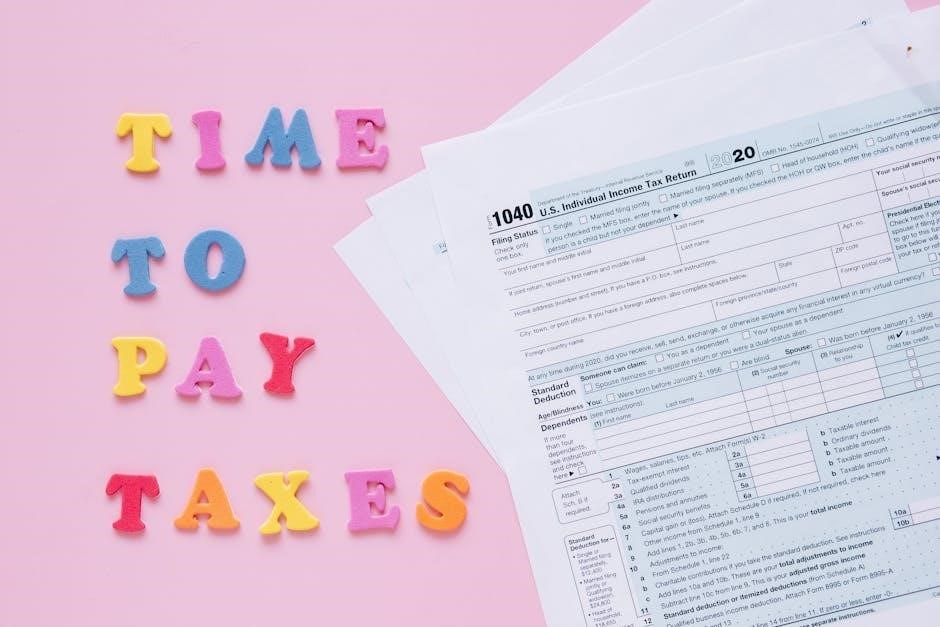The Federal Income Tax and Benefit Guide Line 12100 provides essential instructions for reporting investment income, such as interest and dividends. It helps individuals accurately complete their tax returns using the Federal Worksheet, ensuring compliance with tax regulations and maximizing benefits.
Overview of the Federal Income Tax System
The federal income tax system in Canada is designed to collect revenue for government programs and services while ensuring fairness and transparency. It operates on a progressive tax model, where higher income earners are subject to higher tax rates. The system requires individuals to report all taxable income, including employment income, self-employment income, and investment income, on their annual tax return. Taxpayers can claim deductions and credits to reduce their taxable income or the amount of tax owed, such as the Canada Employment Amount, medical expenses, and contributions to registered retirement savings plans (RRSPs).
The Canada Revenue Agency (CRA) provides detailed guides, including the Federal Income Tax and Benefit Guide, to help individuals navigate the tax filing process. These resources outline eligibility criteria for deductions and credits, explain tax rates, and provide instructions for completing tax forms. The federal income tax system also incorporates measures to address foreign income, ensuring compliance with international tax agreements and preventing double taxation. By understanding the federal income tax system, individuals can ensure accurate reporting of their income and maximize their entitlement to benefits and credits.
Key components of the system include tax brackets, tax credits, and the requirement to report all sources of income, such as interest, dividends, and foreign investments. This ensures a balanced approach to taxation, supporting both individual financial well-being and public services.
Understanding Line 12100 in the Federal Tax Guide
Line 12100 is designated for reporting interest and other investment income, such as dividends and foreign investments. It requires accurate completion of the Federal Worksheet to ensure compliance with tax regulations and proper reporting of all applicable income sources.
What is Line 12100?
Line 12100 is a specific section in the Federal Income Tax and Benefit Guide where individuals report their interest and other investment income. It is a crucial part of the tax filing process, ensuring that all applicable income sources are accurately documented. This line is designed to capture various types of investment income, including interest from bank accounts, Guaranteed Investment Certificates (GICs), and foreign investments. Additionally, it may include income from Treasury bills and other investment-related proceeds. The information reported on Line 12100 is derived from the Federal Worksheet, which helps taxpayers organize and calculate their investment income systematically. It is essential to complete this line correctly to avoid any discrepancies or issues during the tax assessment process. Proper reporting on Line 12100 ensures compliance with tax regulations and helps individuals claim the correct amount of benefits and credits they are entitled to. Accurate documentation and adherence to the guidelines provided in the Federal Tax Guide are vital for a smooth and efficient tax filing experience.
Importance of Line 12100 in Tax Filing
Line 12100 plays a critical role in the tax filing process as it ensures accurate reporting of investment income, which directly impacts an individual’s tax obligations and potential benefits. By completing this line, taxpayers provide the Canada Revenue Agency (CRA) with a clear picture of their investment earnings, which are essential for determining their overall tax liability. Failure to report income on Line 12100 can lead to penalties, fines, or delays in processing tax returns. Additionally, accurate reporting ensures that individuals can claim all eligible credits and deductions, maximizing their tax savings. The information entered on Line 12100 is derived from the Federal Worksheet, which helps organize and calculate investment income systematically. This line is particularly important for individuals with multiple sources of investment income, as it streamlines the reporting process and reduces the risk of errors. Proper compliance with Line 12100 requirements also facilitates smoother audits and ensures that taxpayers meet all legal obligations. In summary, Line 12100 is a vital component of tax filing, promoting transparency, accuracy, and compliance with federal tax regulations.
Federal Worksheet for Line 12100
The Federal Worksheet for Line 12100 is a crucial tool designed to help taxpayers accurately calculate and report their investment income. This worksheet is typically found in the Federal Income Tax and Benefit Guide and is essential for organizing and summing up various types of investment income, such as interest, dividends, and foreign income. By completing the worksheet, individuals can ensure that all relevant income sources are accounted for before entering the total on Line 12100 of their tax return.
The worksheet provides a structured format to list and calculate income from multiple sources, including joint investments, foreign investments, and other investment-related earnings. It also helps in identifying any amounts that may have been reported in previous years, ensuring no double reporting occurs. Taxpayers are required to complete the chart for Line 12100 and other related lines, such as 12000, 12010, and 22100, to ensure accuracy and compliance with tax regulations.
Using the Federal Worksheet for Line 12100 simplifies the tax filing process and reduces the risk of errors. It is particularly useful for individuals with complex investment portfolios or multiple income sources. The CRA also provides additional resources and guidance to help taxpayers navigate the worksheet and ensure all requirements are met. Accurate completion of this worksheet is vital for a smooth and compliant tax filing experience.

Types of Income Reported on Line 12100
Line 12100 reports various investment income types, including interest, dividends, foreign investments, and other investment earnings, ensuring comprehensive tax reporting, accurate financial disclosure, and compliance with federal tax regulations as outlined in the guide for individuals and businesses.
Interest Income
Interest income reported on Line 12100 includes earnings from various financial instruments and accounts. This encompasses bank account interest, Guaranteed Investment Certificates (GICs), and Treasury bills (T-bills). It also covers interest from joint investments, where the share is based on the contributor’s portion. The Federal Worksheet helps calculate and consolidate these amounts, ensuring accurate reporting. Interest is generally taxable when received, and all such income must be included in the tax return. Proper documentation, such as T-slips or statements, is essential for verification. The guide provides detailed instructions to ensure compliance with tax regulations and accurate reporting of interest income on Line 12100.
Dividend Income
Dividend income is another key component reported on Line 12100 of the Federal Income Tax and Benefit Guide. This includes dividends received from Canadian corporations, as well as foreign dividend income. The Federal Worksheet is essential for calculating and consolidating these amounts, ensuring accurate reporting. Dividends are considered taxable income and must be reported in the year they are received. The guide provides specific instructions for distinguishing between eligible and non-eligible dividends, as this distinction affects the tax treatment. Additionally, taxpayers may be entitled to a federal dividend tax credit, which reduces the taxable amount of dividend income. Proper documentation, such as T-slips, is required to support the reported amounts. The guide also addresses the treatment of reinvested dividends, which must still be included in taxable income. By following the instructions in the Federal Worksheet, individuals can ensure compliance with tax regulations and accurately report their dividend income on Line 12100. This section of the guide is crucial for investors and individuals with dividend-bearing investments, providing clarity and examples to simplify the reporting process.
Foreign Investment Income
Foreign investment income reported on Line 12100 includes earnings from international sources, such as foreign interest, dividends, and business income. The Federal Income Tax and Benefit Guide emphasizes the importance of disclosing all foreign income, regardless of its origin. Taxpayers must report these amounts in Canadian dollars, using the exchange rate at the time of receipt. The Federal Worksheet is crucial for calculating and consolidating foreign income, ensuring accurate reporting. Foreign investment income may also be subject to foreign tax credits, which can reduce the taxable amount in Canada. Additionally, individuals with foreign investments must comply with reporting requirements for foreign property, such as filing the Foreign Income Verification Statement. The guide provides detailed instructions for handling foreign income, including how to account for taxes paid in other countries. Proper documentation, such as foreign tax receipts and statements, is essential to support the reported amounts. By adhering to the guide’s instructions, taxpayers can ensure compliance with Canadian tax laws and accurately report their foreign investment income on Line 12100. This section is vital for individuals with international investments, offering clarity on complex reporting requirements.
Other Investment Income
Other investment income reported on Line 12100 includes various types of earnings not classified as interest or dividends. This category may encompass income from Treasury bills (T-bills), Guaranteed Investment Certificates (GICs), and other investment vehicles. The Federal Income Tax and Benefit Guide provides detailed instructions for reporting these amounts, ensuring accurate tax filings. Taxpayers must complete the Federal Worksheet to consolidate all investment income, including other investment income, before entering the total on Line 12100. The guide emphasizes the importance of including all relevant income sources, as omission can lead to underreporting and potential penalties. Additionally, foreign investment income must be converted to Canadian dollars using the appropriate exchange rate. The guide also outlines how to report income from joint investments, ensuring each taxpayer’s share is accurately reflected. Proper documentation, such as investment statements and receipts, is essential to support the reported amounts. By following the guide’s instructions, individuals can ensure compliance with tax regulations and accurately report their other investment income on Line 12100. This section is crucial for taxpayers with diverse investment portfolios, offering clarity on reporting requirements for non-traditional income sources.

Calculating Total Investment Income for Line 12100
Calculating total investment income for Line 12100 involves consolidating all relevant income sources, including interest, dividends, and other investment earnings. The Federal Worksheet provided in the tax guide is essential for this process, as it helps organize and sum up the various components of investment income. Taxpayers must gather all applicable T-slips, such as T3, T4PS, and T5 statements, which detail interest and dividend payments. Foreign investment income, including amounts from foreign bank accounts or investments, must also be converted to Canadian dollars using the appropriate exchange rate and included in the calculation. Additionally, income from joint investments should be reported based on the taxpayer’s contribution to the investment. The total investment income is then transferred to Line 12100 of the tax return. It is crucial to ensure accuracy in these calculations, as errors can lead to underreporting or overreporting of income, potentially resulting in penalties or delays in processing the return. The Federal Worksheet serves as a helpful tool to simplify this process and ensure compliance with tax regulations. Proper documentation, such as investment statements and receipts, should be retained to support the reported amounts. By carefully following the guide’s instructions, taxpayers can accurately calculate their total investment income for Line 12100 and complete their tax return efficiently.

Deductions and Credits Related to Investment Income
Deductions and credits related to investment income reported on Line 12100 can significantly reduce taxable income and lower overall tax liability. Common deductions include investment expenses, such as management fees, safe-deposit box rentals, and investment counseling costs. These expenses can be claimed on Schedule A or directly on the Federal Worksheet. Additionally, foreign tax credits may be available for taxes paid on foreign investment income, ensuring taxpayers are not double-taxed. The Canada Revenue Agency (CRA) provides specific guidelines on eligible deductions and credits, which must be supported by proper documentation. Credits, such as the foreign tax credit, are calculated using Schedule 1 and can directly offset taxes owed. It is essential to accurately calculate and claim these deductions and credits to maximize tax savings. Taxpayers should consult the Federal Income Tax and Benefit Guide or seek professional advice to ensure compliance and optimize their return. Proper documentation, such as receipts and statements, is crucial to support claimed deductions and credits. By leveraging these opportunities, individuals can minimize their tax burden while adhering to tax regulations.
Filing Requirements and Deadlines for Line 12100
Filing requirements and deadlines for Line 12100 are critical to ensure compliance with tax regulations and avoid penalties. The standard deadline for filing individual tax returns, including reporting investment income on Line 12100, is April 30th of each year. However, if April 30th falls on a weekend or a holiday, the deadline is extended to the next business day. Taxpayers can request an extension, which may provide an additional six months, but any taxes owed must still be paid by the original deadline to avoid interest and penalties.
Failure to report investment income on Line 12100 or missing the filing deadline can result in penalties, interest, and delayed refunds. The Canada Revenue Agency (CRA) encourages electronic filing for faster processing and reduced errors. Taxpayers must ensure all required documentation, such as T-slips and the Federal Worksheet, are accurately completed and submitted. For self-employed individuals or those with complex investment income, additional forms or schedules may be necessary. The CRA also offers resources and support to help taxpayers meet their filing obligations on time. Proper planning and timely submission are essential to avoid complications and ensure compliance with federal tax requirements.
Tax Changes and Updates Affecting Line 12100
Recent tax changes and updates have introduced adjustments that may impact how investment income is reported on Line 12100. For instance, inflation adjustments have led to revised tax brackets for 2026, which could affect the taxable portion of investment income. Additionally, new regulations regarding state and local tax deductions may influence how certain investment-related expenses are claimed, potentially altering the net income reported on Line 12100.
The Canada Revenue Agency (CRA) has also introduced updates to the Federal Worksheet, which is used to calculate the income reported on Line 12100. These changes aim to simplify the reporting process and ensure accuracy. Furthermore, modifications to the Income-Related Monthly Adjustment Amount (IRMAA) for Medicare Part B and Part D premiums may indirectly affect taxpayers with higher incomes, potentially influencing their overall tax liability. Taxpayers are encouraged to review the latest CRA guidelines and consult the Federal Income Tax and Benefit Guide to ensure compliance with these updates. Staying informed about these changes is crucial to avoid errors and maximize benefits when filing taxes.

Compliance and Audit Considerations for Line 12100
Compliance with Line 12100 requirements is crucial to avoid audits and penalties. Taxpayers must ensure all investment income, including interest, dividends, and foreign income, is accurately reported. The Canada Revenue Agency (CRA) closely reviews Line 12100 for discrepancies, so maintaining detailed records of investment transactions is essential. Proper documentation, such as T-slips and bank statements, supports the accuracy of reported income and helps in case of an audit.
Understanding CRA guidelines and recent tax changes is vital for compliance. For example, failing to report foreign investment income or incorrectly calculating interest from joint accounts can trigger audits. Taxpayers should also be aware of penalties for underreporting income or claiming ineligible deductions. Regularly reviewing the Federal Income Tax and Benefit Guide ensures adherence to updated regulations.
Additionally, the Federal Worksheet for Line 12100 must be completed accurately to reflect all investment income. Any errors or omissions can lead to reassessments or additional taxes owed. Consulting tax professionals or using certified tax software can help mitigate risks and ensure compliance with CRA requirements. Staying informed and organized is key to avoiding audit issues related to Line 12100.

Benefits and Credits for Specific Groups

Line 12100 of the Federal Income Tax and Benefit Guide is designed to accommodate various benefits and credits tailored to specific groups. For instance, seniors, students, and first-time homebuyers may qualify for targeted tax relief. The guide outlines how these groups can claim deductions or credits related to their investment income, ensuring they maximize their tax savings.
Seniors, for example, may benefit from pension income splitting, which can reduce their taxable income. Students can claim interest from student loans, while first-time homebuyers may deduct mortgage-related expenses. Additionally, individuals with disabilities can access credits for medical expenses, further reducing their tax liability. These provisions ensure fairness and support for vulnerable populations.
The Federal Worksheet for Line 12100 also addresses foreign income reporting, which is critical for expatriates or those with international investments. Credits for foreign taxes paid can help avoid double taxation, making it easier for these individuals to comply with tax obligations. Overall, Line 12100 is structured to provide equitable tax solutions for diverse groups, ensuring everyone can benefit from the tax system.

Relevant Forms and Schedules for Line 12100
When completing Line 12100 of your Federal Income Tax and Benefit Guide, several key forms and schedules are essential to ensure accurate reporting of investment income. The primary form is the T1 General, where Line 12100 is located. Additionally, the Federal Worksheet is crucial for calculating and summarizing the total investment income to be reported on this line.
Supporting documents such as T3 (Statement of Trust Income Allocations and Designations) and T4 (Statement of Remuneration Paid) may also be required, depending on the source of income. For foreign investment income, T12000 (Statement of Foreign Income) is necessary to report earnings from international sources. Furthermore, Schedule 4 (Statement of Investment Income) is used to detail interest, dividends, and other investment-related income.
These forms and schedules help taxpayers organize their financial data, ensuring compliance with CRA requirements. By accurately completing these documents, individuals can avoid errors and ensure their tax return is processed efficiently. Proper use of these forms is vital for maximizing benefits and minimizing tax liabilities related to investment income reported on Line 12100.
Impact of Tax Law Changes on Line 12100
Tax law changes can significantly impact the reporting requirements for Line 12100, which pertains to interest and other investment income. Recent updates, such as inflation adjustments and new tax brackets for 2026, may alter the thresholds for reporting certain types of income. For instance, the IRS has introduced changes to accommodate inflation, potentially affecting how investment income is calculated and reported on Line 12100.

Additionally, modifications to deductions and credits related to investment income, such as the Interest Related Monthly Adjustment Amount (IRMAA), can influence the net income reported on this line. Taxpayers must stay informed about these changes to ensure compliance and avoid penalties. The CRA and IRS regularly update their guidelines, so consulting official resources like canada.ca or irs.gov is essential for accurate reporting.
Furthermore, changes in tax treaties or international agreements may affect how foreign investment income is reported on Line 12100. Taxpayers with foreign income must review the latest regulations to ensure proper compliance. Staying updated on tax law changes is crucial for accurately completing Line 12100 and maximizing tax benefits.
Reporting Foreign Income on Line 12100
Reporting foreign income on Line 12100 is a critical aspect of tax compliance for individuals with international investments. This line is designated for interest and other investment income, including foreign earnings. Taxpayers must report all foreign income, such as interest from foreign banks, dividends from foreign corporations, and proceeds from foreign investments, on this line.
Foreign income must be converted to Canadian dollars using the exchange rate in effect at the time of receipt. Additionally, any foreign tax withheld on this income should be reported separately, as it may be eligible for a foreign tax credit. The Federal Worksheet for Line 12100 provides a structured approach to calculating and reporting these amounts accurately.
It is essential to ensure that all foreign income is included, even if tax was withheld in the country of origin. Failure to report foreign income can result in penalties and interest. Taxpayers should consult the CRA guidelines or the Canada.ca resource for specific instructions on reporting foreign income on Line 12100. Proper documentation and accurate reporting are crucial to avoid compliance issues.

Case Studies and Examples for Line 12100
Understanding Line 12100 through real-world examples helps taxpayers accurately report their investment income. For instance, if an individual earns $1,000 in interest from a Canadian bank account and $500 from a foreign investment, both amounts should be reported on Line 12100. The foreign income must be converted to Canadian dollars using the applicable exchange rate.
Another example involves joint investments. If two individuals equally contribute to a joint account earning $2,000 in interest, each should report $1,000 on their respective Line 12100. This ensures accurate reporting based on contribution percentages.
For foreign income, consider an individual with $3,000 in dividends from a U.S. corporation. This amount is reported on Line 12100, along with any foreign taxes withheld, which may qualify for a tax credit. These examples highlight the importance of proper documentation and accurate conversion of foreign income.
By reviewing these case studies, taxpayers can better understand how to apply the Federal Worksheet for Line 12100 and ensure compliance with tax regulations. Accurate reporting of all investment income is essential to avoid penalties and optimize tax benefits.
Conclusion
Line 12100 of the Federal Income Tax and Benefit Guide is a critical component for accurately reporting investment income, such as interest, dividends, and foreign earnings. Properly completing this line ensures compliance with tax regulations and helps individuals avoid penalties. By using the Federal Worksheet and carefully reviewing all relevant income sources, taxpayers can ensure their returns are accurate and maximize their benefits. Understanding Line 12100 is essential for navigating the complexities of investment income reporting, especially for those with foreign investments or joint accounts. The guide provides detailed instructions to help taxpayers meet all requirements, ensuring they take advantage of eligible credits and deductions. Staying informed about tax law changes and seeking professional advice when needed can further simplify the process. Ultimately, Line 12100 plays a vital role in ensuring accurate and efficient tax filing for individuals with investment income.
